The market demand and price of pineapple is attractive, So many people are thinking of starting a commercial pineapple farming. If you are also one of them who is looking for a detailed guide on cultivation practices in Pineapple farm, then, You are at right article my friend.
Pineapple is full of pleasent aroma which taste sweet and sour. It has great health benefits and high market value.So, pineapple Farming is getting popular all over the world.
Pineapple is shrub of family Bromeliaceae. The scientific name of pineapple is Ananas comosus. This fruit is native to South America and Southern area in Guyana.
The skin of pineapple is rough and prickly and called rind. The pineapple is called so because it looks like pine cone from its outer surface.
We can found vitamin A,B and C(more) along with minerals like calcium, magnesium and Iron along with a digestive enzyme called Bromelian.
The use of pineapple fruit is wide as it can be eaten in fresh, juices and many other processed form.
In this blog we are going to guide you on Pineapple Farming, Cultivation Techniques and about the Profit that you can earn from this business.
Pineapple Farming
Pineapple farming is getting popular day by day because of its high market value and easy to do farming business.
One can shine their life and can maintain good standard of living by involving in pineapple farming.
Pineapple is said have originated from south America. Then, pineapple farming started in Brazil, Prague and now it is cultivated in different parts of the world like Hawaii, Panama, Costa rica, Honduras, Philippines.
However, Costa rica is leading in pineapple production followed by Philippines and Brazil.
There are certain things that one should learn before starting pineapple cultivation. These precious things are discussed below.
Variety selection
While starting any farming business, our entire production and profit depends on the variety we selected. Thus, selection of good variety is crucial step one should follow in pineapple farming.
Pineapple has mainly 2 varieties which gives good production and which are widely cultivated in different parts of the world. They are:-
✓Kew-They have long smooth eaf. They weight (2-3)kg. They are ready to harvest in july to September.
✓Queen- They have short leaves with thrones. Fruits colour is golden yellow and it taste very good with pleasent smell.They also wight (1-2)kg.
There are altogether 37 varieties of pineapple which can be cultivated. Some of them are:-
✓Giant Kew
✓Red Spanish
✓Smooth Cayenne
✓Brecheche
✓Abacaxi
✓Mauritius
✓Pernambuco
✓Antigua Black(Sweetest)
Some of the commercially cultivated varieties of pineapple are explained below:-
1. Queen
It is outstanding table cultivar. The fruit has prominent, deep and irregular eyes, So – It is unsuitable for canning purpose. The leaf margin of this cultivar is serrated with closely packed spines. The fruit is cylindrical with weight of around 1.25 kg. It has characteristics of uniform ripening and good keeping quality.
2. Cayenne
Cayenne is the most popular in commercial pineapple farming. The eyes are flat or shallow. Therefore, It is suitable for canning purpose. The leafs are smooth with spines only at the tip. The fruit is cylindrical, yellow pulp colour, has high yield with mild acid taste. This cultivar is susceptible to Pineapple Mealybug Wilt.
3. Spanich
This cultivar has globose shaped fruit with deep and prominent eyes. The leaves are spiny and is resistant to PMW.
4. Abacaxi
This cultivar is famous in Brazil. It is erect with spiny leaves. The fruit is pyramidal shape with the weight of around 1.5 kg. It is resistant to Pineapple Mealybug Wilt.
5. Maipuri
This cultivar fruit has deep eyes, So – It isn’t suitable for canning purpose. The fruit is cylindrical in shape. The leaves are smooth with folded margin.
Climate
Pineapple is tropical plant i.e Pineapple farming is good in area of decent rainfall along with some hotness.The temperature requirement for pineapple farming is (15-32)°C.
If the temperature is too low, then the taste of pineapple becomes too sour and if the temperature is too high, then pineapple taste too sweet.
Pineapple farming can be done up to the altitude of 1400m from sea level and average rainfall requirement is 1500mm per year. Frost isn’t tolerated but mild cool weather improves fruit quality. It also has xerophytic character i.e. The leaves of Pineapple has water storing parenchyma that serves as a reservoir of moisture during drought.
Soil Required/Edaphology
Pineapple farming can be done in wide variety of soil. However, Sandy loam soil rich in nutrients and micro-organisms is considered best for pineapple. Clay soil is bad to do pineapple farming.
The soil should have good drainge with pH range of (4.5-5.5) i.e Slightly acidic. Acidic soil reduces heart rot caused by Phythopthera. In areas where soil pH is close to neutral, Foliar application of Iron sulphate should be done. Inability to obtain iron from iron rich soil under certain conditions is peculiarity of pineapple not shared by other plants.
Land preparation For Pineapple Farming
Before starting pineapple farming, selection of good piece of land is necessary.
Operations like primary and secondary tillage, reclamation of land, levelling of land and making ridges and furrows are done in land preparation.
It is better to choose plain land instead of sloppy land. The land should be such place where pineapple gets full sunlight during whole day. Sunlight helps to fruit faster in pineapple. We can also do pineapple farming in half shade condition.
Unwanted materials, large stones, weeds and other materials which can affect the growth of pineapple tree are removed from site.
One of the main operation in land preparation is doing layout design of an orchard. We need to make certain map or lines depending on system of planting whether it is Square, Rectangle, Hexagonal or Triagular system. and select spot for planting in doing layout of an orchard.
Similarly, after finishing layout operation like pit digging should be done in order to plant pineapple tree in that pit.
For pineapple, we need to make rows. The width of 100 cm should include 2 rows. Then,we need to dig pits in rows where plantation is to be done.
These all activities of land preparation should be done (1-2)months prior to planting season.
planting season
Pineapple is planted during rainy season when there is good humidity. This helps in success of pineapple growth. Winter planting can also be done if proper irrigation facility is available.
Planting Material
The pineapple farming can be done by using planting materials like Suckers, Crown, Slip, and tissue culture plant.
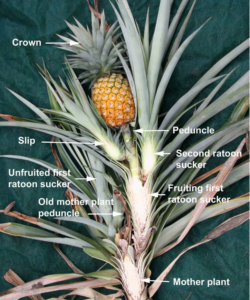
Suckers are new pineapple shoots which grow from the axils of the leaves just below the ground. Pineapple regrows from suckers and produces fruit. So, we can harvest pineapple multiple time after one plantation. These suckers start to give fruit after 12-14 months of planting.
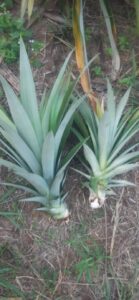
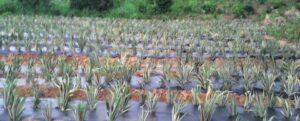
Slips are stem of pineapple. Slip supports fruit and crown. Actually, Slips are the basal suckers. They start bearing fruits after 14-16 months of planting.
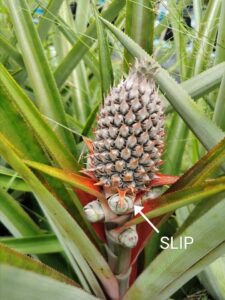
Crowns are the clusters of thick spiky leaves at the top of fruit. Crown also protect fruit from hot sunlight. Pineapple can also be grown from crowns. Among these three, Crown isn’t preferred to produce new fruits and even if they are used, it takes about 24 months for fruiting.

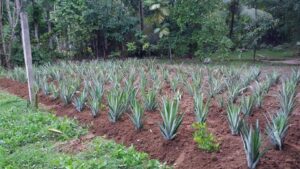
Suckers and Slip are generally preferred for planting. To avoid the rotting of plants after planting, Suckers and Slips are cured by stripping off the lower leaves followed by drying in sun or in partial shade for about a week before planting. Sucker is considered the best planting material for pineapple. It should be dipped in fungicide and should be planted at least 15 cm deep.
Planting distance and area
We need to maintain proper planting distance for pineapple cultivation. There should be proper space for the growth and development of pineapple.
Pineapple can be planted either in single row or in double row.
✓For Single Row:- Plant to Plant distance is 60 cm and Row to Row distance is 150 cm. This allows for a population of 11,000 plants/ha.
✓ For Double Row:- Plant to Plant distance is 30 cm, Row to Row distance is 60 cm and Bed to Bed distance is 90 cm. This allows for a population of 43,500 plants/ha. This method is more prefered in Pineapple farming as it includes more number of plants per area which obviously increase our yield and profit.
Pineapple should be plant at the depth of 15 cm from surface.
Fertilizers
During planatation, we need to add fertilizers in soil. We should make mixture of N,P,K Animal manure and Plot soil and fill the pit.
The quantity of fertilizers to be used in pineapple farming are:-
✓Nitrogen=16gm
✓Phosphorous=5gm
✓Potash=12gm
This amount of fertilizer is for per plant per year. The amount of FYM required is 30 ton per hectare. Full dose of FYM, Phosphorus, Potash and half dose of Nitrogen is applied during planting time. Remaining half dose of Nitrogen should be applied in two split doses i.e. During May and June
.
During planatation, we need to add fertilizers in soil. We should make mixture of N,P,K Animal manure and Plot soil and fill the pit.
This amount of fertilizers are used in only one pit. The same quantity should be added for every plant.
Pineapple response well to the foliar application of fertilizers like N, B, Fe, Zn and sometimes potassium can also be applied by this method. The amount of Manganese in soil should always be less than iron. Soil with high manganese can result in Manganese induced iron chlorosis. However, Iron chlorosis can easily be cured with regular foliar application of Iron sulphate usually forenightly. The rate of FeSO4 is 70 kg/ha.
After plantation:-
Urea should be applied after every 2 months for 1 years i.e Urea should be applied for 6 times after planting pineapple tree.
Potassium should be applied in every 6 months for 1 year i.e for 2 times.
Among all fertilizers, Nitrogen and Potassium has main role in production of pineapple.
Irrigation
Pineapple requires less water. So, we don’t need to worry so much about irrigation in pineapple farming.
We can irrigate two times every 1 month on dry season. Irrigation frequency depends on the climate where pineapple farming is done.
Weed Control
Weeds are any unwanted grasses that compete with our main crop for Nutrients, Water, Sunlight and Space which ultimately reduce our production. As Pineapple is slow growing fruit, Initially weeds easily supress the fruit plant. So, Regular wedding is necessary. Manual weeding is very difficult due to presence of spines. So – Chemical weedicides can be used. The recommended weedicides for Pineapple Farming are:-
✓ Bromacil + Diuron @ 2Kg/ha as Pre-emergence
✓ Glyphosate @ 2Kg/ha as Post-emergence
2,4 – D shouldn’t be used to control weed as it can cause adverse effect in flowering of Pineapple.
Harvesting
The flowering of pineapple starts after (15-18) months of plantation. The fruits of pineapple are ready to harvest after (4-5) months of flowering.
The flowering in pineapple starts in february to april and fruits can be harvested in july to september.
Actually In pineapple, the flowers comes at centre of plant surrounded by outer leaves. The number of flowers are about (100-300). These flowers forms many small berries.
These berries fuses and forms a single pineapple fruit. Harvesting should be done after the ripening of pineapple fruit as it is non – climatric fruit. There is a problem of erratic or irregular flowering behaviour in Pineapple which can be controlled by:-
•Flowering in pineapple can be induced if the stems are kept horizontal, due to geotropism, the auxin hormone is accumulated at the bud initiation point.
•Use of Napthalene Acetic Acid (NAA) and Ethrel.
•Use of 100 ppm Ethrel + 2% Urea + 0.004% CaCO3
These treatment should be given 2 months earlier to flowering period, during the month of Nov which induces uniform flowering during the month of Feb – April.
We can identify if they are ripen or not by observing the change in colour as it turns to golden yellow and pineapple fruit also spread aroma.
Some harvesting indices of of Pineapple during Pineapple Farming are:-
✓Dark green leaves changes to yellow
✓The eyes of fruit becomes less angular i.e they become flattened. Though, It isn’t applicable for cayenne as it already has flat eyes.
✓The bracts that protect the eye dry off.
✓Metallic Sound – Not ready for harvesting
✓Dull Sound – Ready for harvesting
After first harvest, soil should be added on roots. This will help to get good production in next harvest. The pineapple can be regrown after first harvest as it produces suckers.
Tip:-To increase the size of pineapple fruit, we need to apply 1ml Planofix(10ppm) dissolved in 4.5 litre water.
Similarly, 2-3 gm Napthalene acitc acid (250ppm) dissolved in 10 litre water can be applied.
These fruit size increasing chemicals should be applied after (1-2) months of fruiting and it helps to increase the size of pineapple fruit by (15-20)%. During storage, Pineapple should be stored at (7-12)°C.
Marketing
The demand of pineapple is high in market and demand increases in summer as more people consume fruits.
Pineapple is eaten in fresh condition. People love to drink the juice of pineapple. Many companies also buy pineapple to make processed cans.
For marketing, pineapples should be harvested when they are 80% riped but to directly eat, pineapple should be 100% riped.
Storage
Ripened pineapple cannot be stored for long duration. They should be consumed within (5-6) days of harvest. If we become unable to sell, then it can be preserved in cold storage at the temperature of (1-5)°C
Investment And Profit Per Acre
The investment for pineapple farming in an area of 1 acre is Rs.1.5 Lakhs IC and our income from the same area if everything goes on right way is 3 Lakhs IC.
So, our profit in pineapple farming is 1.5 lakhs IC on an area of 1 acre.
Insects/Pests In Pineapple
1. Mealy Bug
Mealy bugs are small white pest which sucks the cell sap from fruits, crown and roots. The plant show different symptoms in response to mealy bug attack. The peculiar symptom is:- Leaves colour changes from green to red or pink and the margins reflect inwards and leaf tip starts drying.
Control:-
✓Dip planting material in Fenitrothion or Phenthoate for 15 minutes.
✓Use Phorate Granules @1.75Kg/ha after 3 months of planting.
2. Termites
They are small ant like reddish pests that is seen in Pineapple Farming which is established in sandy soil.
Control:-
✓Use of Chloropyriphos and Regular irrigation reduces the termite infestation.
3. Beetle
They feed inside the ripen fruits causing the rotting of fruit which has no value.
Control:-
✓ Pick the fruits before they ripen.
Diseases
1. Mealy Bug Wilt
Bronze to Red colour appears from third to fourth whorl outwards, leaves show inner reflexing of margins, central whorl upright but without turgor, leaf black, root decay, wilting and death of plant.
✓Control :- Hot water treatment for planting material @ 50 – 60 ° C temperature and application of Disyton at the base of plant @1.5 kg
Physiological Disorders In Pineapple
Some of the disorders that you might face during the Pineapple Farming are:-
1. Chilling Injury
When a fruit are kept at very low temperature, then – They suffer from a disorder called chilling Injury. Temperature fruit can withstand the very low temperature than tropical fruits. Being, Tropical fruit, The best temperature for the storage of Pineapple is (7-12)° C. Below, 7 ° C, Brown spots are seen in the flesh of fruit termed as Endogenous Brown Spot.
2. Sun Burn / Scald
When the temperature goes above 35 ° C, Scorching sunshine cause whitish yellow patches develop on skin of fruit and brown patches are seen on fruit flesh.
3. Multiple Crowning
Occasionally, A plant may bear two or three crowns instead of the normal i.e. one. It is a genetic as well as environmental influenced disorder. High fertility of soil and rapid growth followed by a period of drought at the time of inflorescence initiation favours multiple Crowning.
Benefits Of Pineapple
1.Pineapple has many health benefits, some of which are listed below:-
2.Regular consumption of pineapple helps to cure the problem of Arthritis.
3.Pineapple is very rich in vitamin-C though it contains vita-A and vita-B also.
4.Pineapple helps in preventing cancer of mouth, throat and even of breast.
5.Pineapples improves vision of an eye.
6.Pineapple has antioxidants which purifys our blood and maintains blood pressure.
7.Pineapple improves digestion and make our immune system strong.
8.Pineapple juice helps to lose weight.
9.Pineapple helps to make our skin beautiful and also prevents pimples.
10.Pineapple can be eaten during pregnancy. Folic acid in pineapple is good for baby in womb.
Final verdict
From all the information we learned, it can be concluded that pineapple is like boon in fruit from all perspective.
Pineapple farming has lots of potential and government should also encourage farmer to do pineapple cultivation by giving different subsidy as it is easy to grow and climate require for pineapple is found in almost all countries.
This is whole information on Pineapple Farming, Cultivation Techniques – A Complete Guide.
Also Read:-
Banana Farming: Soil, Variety, Distance And Profit
Multilayer Farming Process And Benefits
Calathea Setosa: Plant Care, Common Name And Propagation

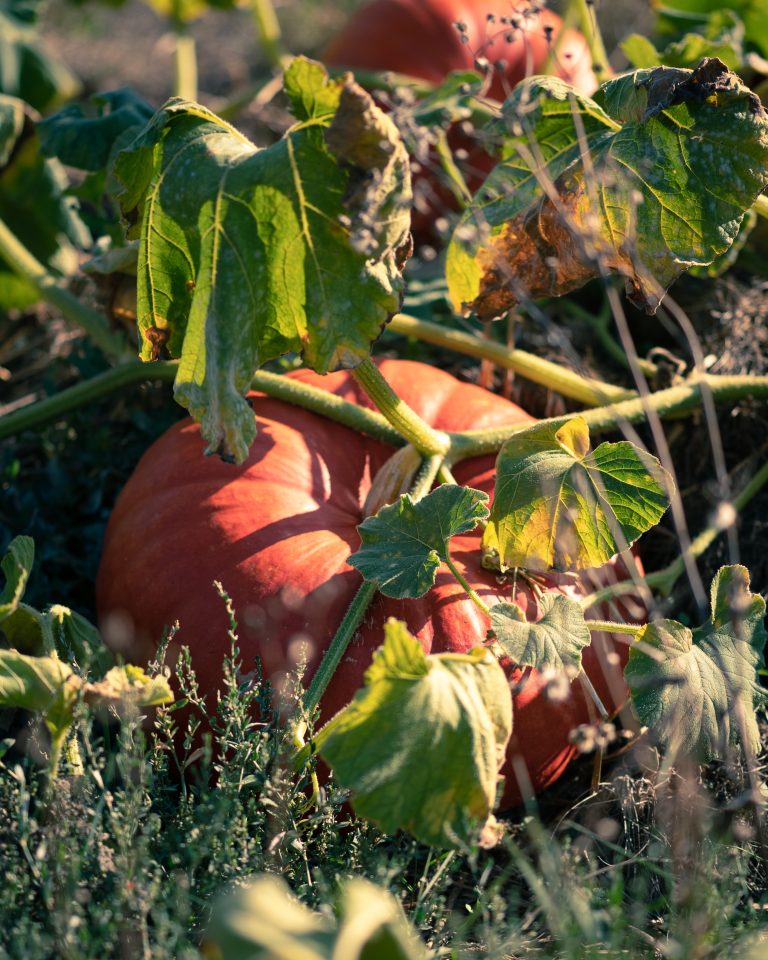
good information
It’s indeed a great achievement to thoroughly understood the whole concept of pineapple cultivation. I’m grateful for everything,and I hope to learn about a lots of other fruits.
We are glad to know this article helped you. We are indeed coming with excellent articles in all fruits. Thank You.